Literature Review: Organisational Culture, Change, and Resistance
VerifiedAdded on 2020/06/03
|9
|1798
|42
Literature Review
AI Summary
This literature review examines the multifaceted concept of organisational culture and its crucial role in business operations. It defines organisational culture as the shared values, beliefs, and behaviors that shape individual conduct within an organisation, influencing how employees perform their duties. The review explores the significance of adapting to change and the challenges of resistance. It delves into the various types of organisational culture, the causes of resistance (fear of the unknown, lack of competence, misunderstanding, poor communication, status quo, and lack of rewards), and the strategies for managing change effectively. Key steps include implementing change management, anticipating resistance, and formalising change management processes involving preparation, management, and reinforcement. The review concludes that organisational culture is a powerful force influencing employee behavior and achieving organisational goals, highlighting the importance of effective change management to overcome resistance and foster growth.
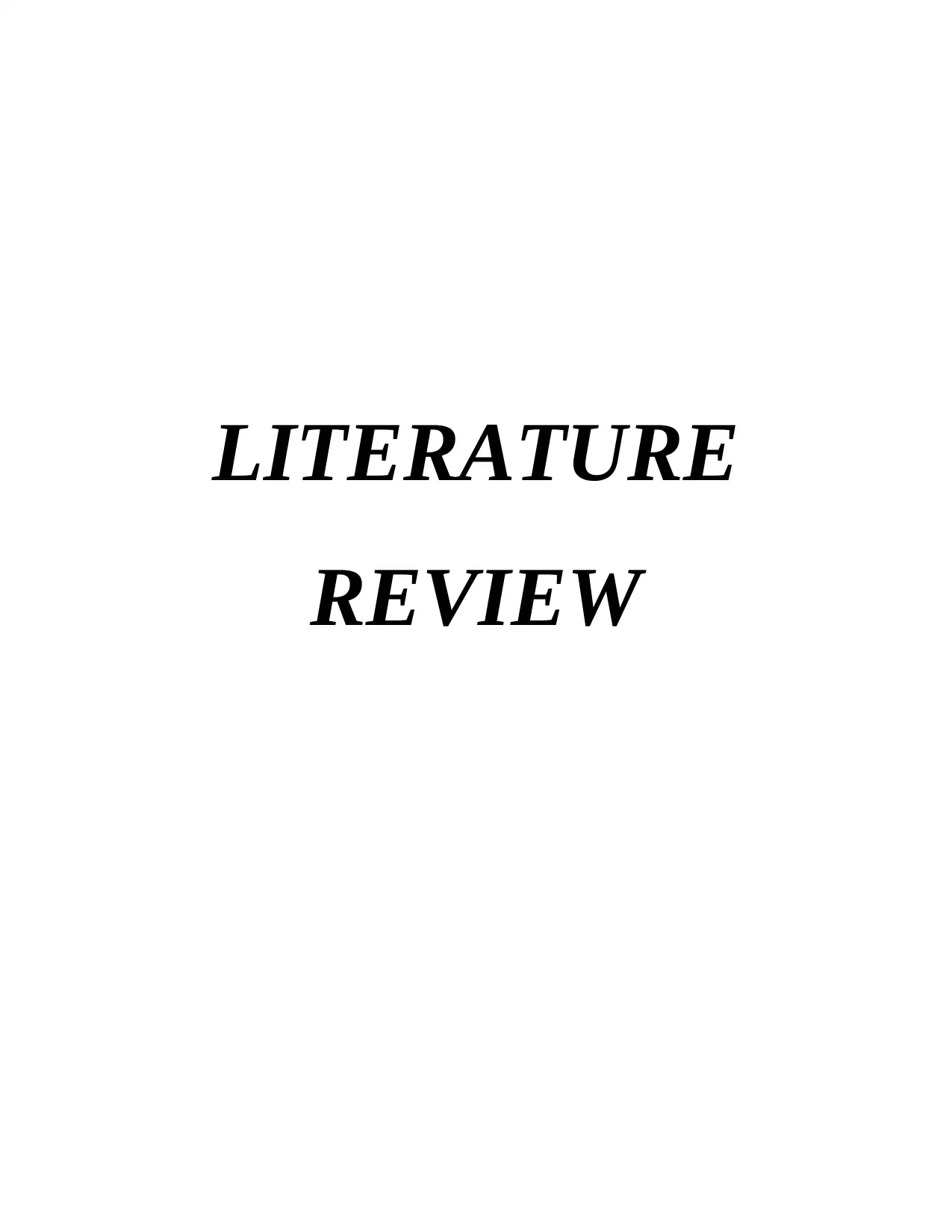
LITERATURE
REVIEW
REVIEW
Paraphrase This Document
Need a fresh take? Get an instant paraphrase of this document with our AI Paraphraser
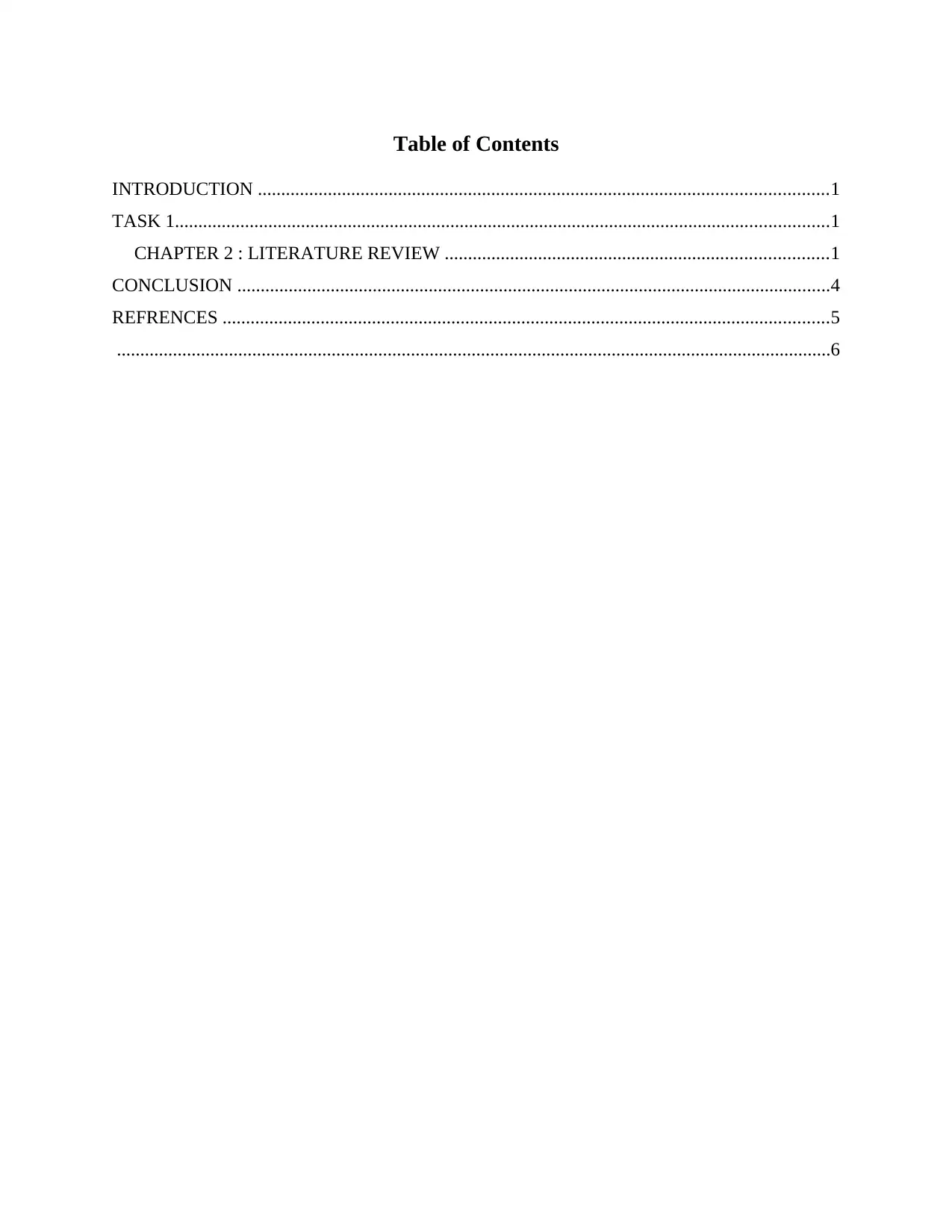
Table of Contents
INTRODUCTION ..........................................................................................................................1
TASK 1............................................................................................................................................1
CHAPTER 2 : LITERATURE REVIEW ..................................................................................1
CONCLUSION ...............................................................................................................................4
REFRENCES ..................................................................................................................................5
.........................................................................................................................................................6
INTRODUCTION ..........................................................................................................................1
TASK 1............................................................................................................................................1
CHAPTER 2 : LITERATURE REVIEW ..................................................................................1
CONCLUSION ...............................................................................................................................4
REFRENCES ..................................................................................................................................5
.........................................................................................................................................................6
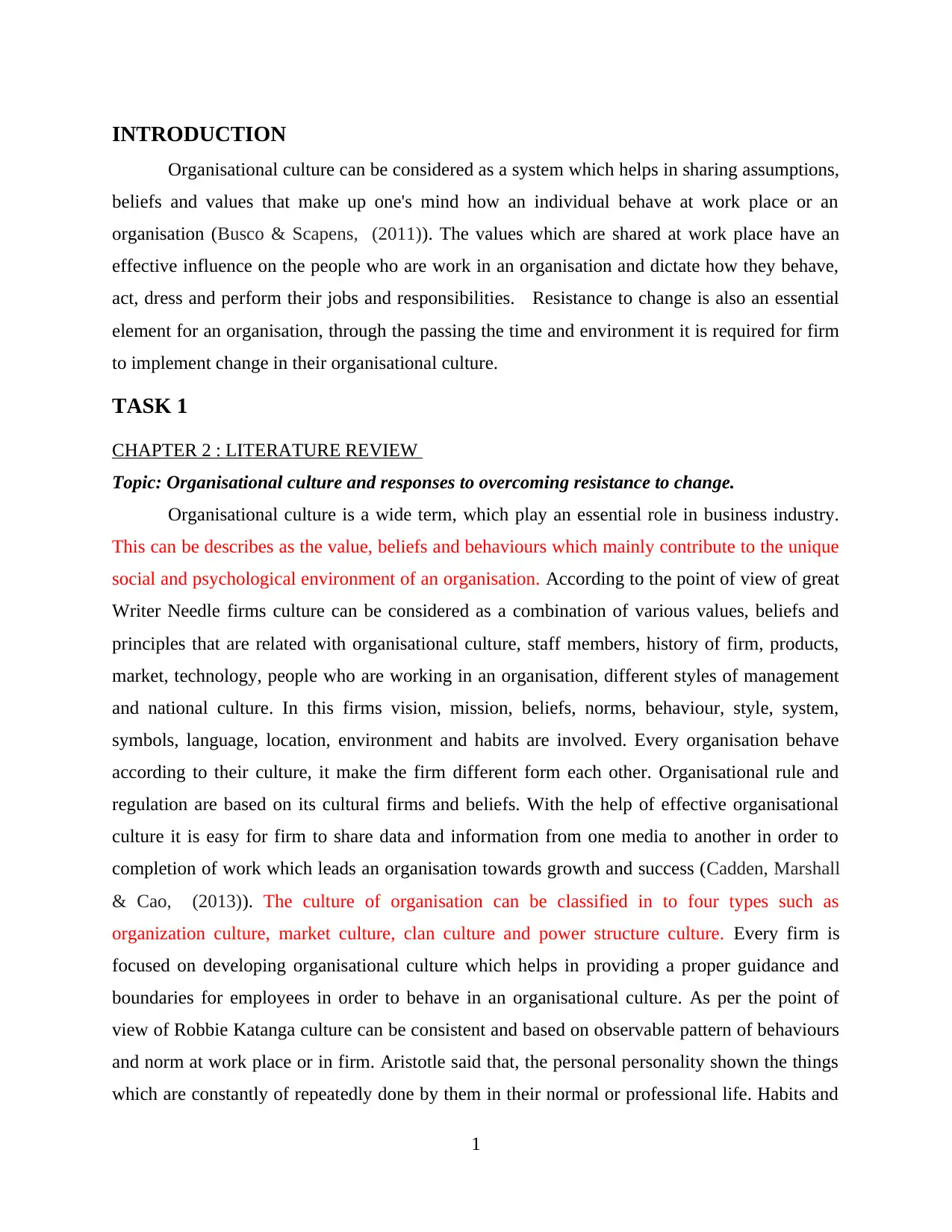
INTRODUCTION
Organisational culture can be considered as a system which helps in sharing assumptions,
beliefs and values that make up one's mind how an individual behave at work place or an
organisation (Busco & Scapens, (2011)). The values which are shared at work place have an
effective influence on the people who are work in an organisation and dictate how they behave,
act, dress and perform their jobs and responsibilities. Resistance to change is also an essential
element for an organisation, through the passing the time and environment it is required for firm
to implement change in their organisational culture.
TASK 1
CHAPTER 2 : LITERATURE REVIEW
Topic: Organisational culture and responses to overcoming resistance to change.
Organisational culture is a wide term, which play an essential role in business industry.
This can be describes as the value, beliefs and behaviours which mainly contribute to the unique
social and psychological environment of an organisation. According to the point of view of great
Writer Needle firms culture can be considered as a combination of various values, beliefs and
principles that are related with organisational culture, staff members, history of firm, products,
market, technology, people who are working in an organisation, different styles of management
and national culture. In this firms vision, mission, beliefs, norms, behaviour, style, system,
symbols, language, location, environment and habits are involved. Every organisation behave
according to their culture, it make the firm different form each other. Organisational rule and
regulation are based on its cultural firms and beliefs. With the help of effective organisational
culture it is easy for firm to share data and information from one media to another in order to
completion of work which leads an organisation towards growth and success (Cadden, Marshall
& Cao, (2013)). The culture of organisation can be classified in to four types such as
organization culture, market culture, clan culture and power structure culture. Every firm is
focused on developing organisational culture which helps in providing a proper guidance and
boundaries for employees in order to behave in an organisational culture. As per the point of
view of Robbie Katanga culture can be consistent and based on observable pattern of behaviours
and norm at work place or in firm. Aristotle said that, the personal personality shown the things
which are constantly of repeatedly done by them in their normal or professional life. Habits and
1
Organisational culture can be considered as a system which helps in sharing assumptions,
beliefs and values that make up one's mind how an individual behave at work place or an
organisation (Busco & Scapens, (2011)). The values which are shared at work place have an
effective influence on the people who are work in an organisation and dictate how they behave,
act, dress and perform their jobs and responsibilities. Resistance to change is also an essential
element for an organisation, through the passing the time and environment it is required for firm
to implement change in their organisational culture.
TASK 1
CHAPTER 2 : LITERATURE REVIEW
Topic: Organisational culture and responses to overcoming resistance to change.
Organisational culture is a wide term, which play an essential role in business industry.
This can be describes as the value, beliefs and behaviours which mainly contribute to the unique
social and psychological environment of an organisation. According to the point of view of great
Writer Needle firms culture can be considered as a combination of various values, beliefs and
principles that are related with organisational culture, staff members, history of firm, products,
market, technology, people who are working in an organisation, different styles of management
and national culture. In this firms vision, mission, beliefs, norms, behaviour, style, system,
symbols, language, location, environment and habits are involved. Every organisation behave
according to their culture, it make the firm different form each other. Organisational rule and
regulation are based on its cultural firms and beliefs. With the help of effective organisational
culture it is easy for firm to share data and information from one media to another in order to
completion of work which leads an organisation towards growth and success (Cadden, Marshall
& Cao, (2013)). The culture of organisation can be classified in to four types such as
organization culture, market culture, clan culture and power structure culture. Every firm is
focused on developing organisational culture which helps in providing a proper guidance and
boundaries for employees in order to behave in an organisational culture. As per the point of
view of Robbie Katanga culture can be consistent and based on observable pattern of behaviours
and norm at work place or in firm. Aristotle said that, the personal personality shown the things
which are constantly of repeatedly done by them in their normal or professional life. Habits and
1
⊘ This is a preview!⊘
Do you want full access?
Subscribe today to unlock all pages.

Trusted by 1+ million students worldwide
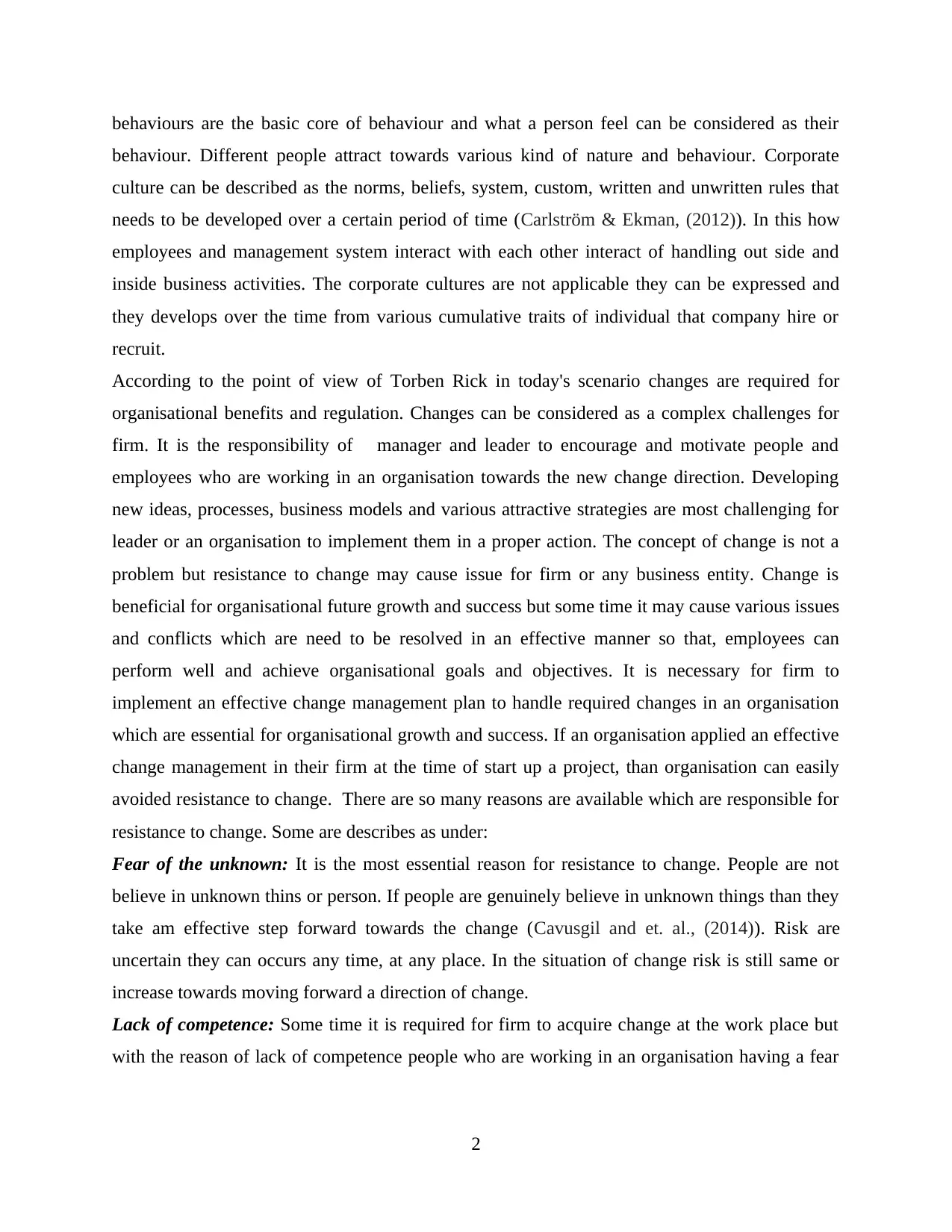
behaviours are the basic core of behaviour and what a person feel can be considered as their
behaviour. Different people attract towards various kind of nature and behaviour. Corporate
culture can be described as the norms, beliefs, system, custom, written and unwritten rules that
needs to be developed over a certain period of time (Carlström & Ekman, (2012)). In this how
employees and management system interact with each other interact of handling out side and
inside business activities. The corporate cultures are not applicable they can be expressed and
they develops over the time from various cumulative traits of individual that company hire or
recruit.
According to the point of view of Torben Rick in today's scenario changes are required for
organisational benefits and regulation. Changes can be considered as a complex challenges for
firm. It is the responsibility of manager and leader to encourage and motivate people and
employees who are working in an organisation towards the new change direction. Developing
new ideas, processes, business models and various attractive strategies are most challenging for
leader or an organisation to implement them in a proper action. The concept of change is not a
problem but resistance to change may cause issue for firm or any business entity. Change is
beneficial for organisational future growth and success but some time it may cause various issues
and conflicts which are need to be resolved in an effective manner so that, employees can
perform well and achieve organisational goals and objectives. It is necessary for firm to
implement an effective change management plan to handle required changes in an organisation
which are essential for organisational growth and success. If an organisation applied an effective
change management in their firm at the time of start up a project, than organisation can easily
avoided resistance to change. There are so many reasons are available which are responsible for
resistance to change. Some are describes as under:
Fear of the unknown: It is the most essential reason for resistance to change. People are not
believe in unknown thins or person. If people are genuinely believe in unknown things than they
take am effective step forward towards the change (Cavusgil and et. al., (2014)). Risk are
uncertain they can occurs any time, at any place. In the situation of change risk is still same or
increase towards moving forward a direction of change.
Lack of competence: Some time it is required for firm to acquire change at the work place but
with the reason of lack of competence people who are working in an organisation having a fear
2
behaviour. Different people attract towards various kind of nature and behaviour. Corporate
culture can be described as the norms, beliefs, system, custom, written and unwritten rules that
needs to be developed over a certain period of time (Carlström & Ekman, (2012)). In this how
employees and management system interact with each other interact of handling out side and
inside business activities. The corporate cultures are not applicable they can be expressed and
they develops over the time from various cumulative traits of individual that company hire or
recruit.
According to the point of view of Torben Rick in today's scenario changes are required for
organisational benefits and regulation. Changes can be considered as a complex challenges for
firm. It is the responsibility of manager and leader to encourage and motivate people and
employees who are working in an organisation towards the new change direction. Developing
new ideas, processes, business models and various attractive strategies are most challenging for
leader or an organisation to implement them in a proper action. The concept of change is not a
problem but resistance to change may cause issue for firm or any business entity. Change is
beneficial for organisational future growth and success but some time it may cause various issues
and conflicts which are need to be resolved in an effective manner so that, employees can
perform well and achieve organisational goals and objectives. It is necessary for firm to
implement an effective change management plan to handle required changes in an organisation
which are essential for organisational growth and success. If an organisation applied an effective
change management in their firm at the time of start up a project, than organisation can easily
avoided resistance to change. There are so many reasons are available which are responsible for
resistance to change. Some are describes as under:
Fear of the unknown: It is the most essential reason for resistance to change. People are not
believe in unknown thins or person. If people are genuinely believe in unknown things than they
take am effective step forward towards the change (Cavusgil and et. al., (2014)). Risk are
uncertain they can occurs any time, at any place. In the situation of change risk is still same or
increase towards moving forward a direction of change.
Lack of competence: Some time it is required for firm to acquire change at the work place but
with the reason of lack of competence people who are working in an organisation having a fear
2
Paraphrase This Document
Need a fresh take? Get an instant paraphrase of this document with our AI Paraphraser
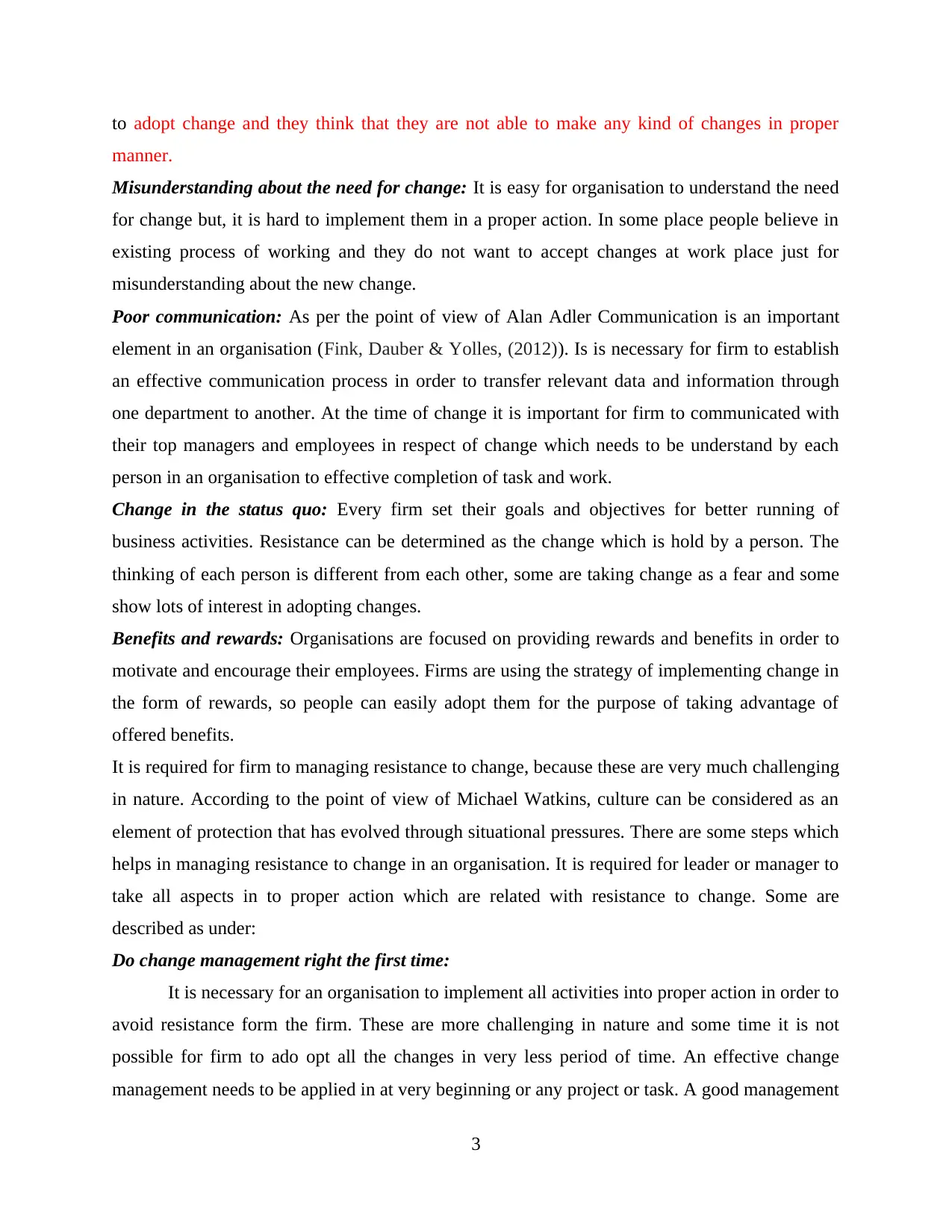
to adopt change and they think that they are not able to make any kind of changes in proper
manner.
Misunderstanding about the need for change: It is easy for organisation to understand the need
for change but, it is hard to implement them in a proper action. In some place people believe in
existing process of working and they do not want to accept changes at work place just for
misunderstanding about the new change.
Poor communication: As per the point of view of Alan Adler Communication is an important
element in an organisation (Fink, Dauber & Yolles, (2012)). Is is necessary for firm to establish
an effective communication process in order to transfer relevant data and information through
one department to another. At the time of change it is important for firm to communicated with
their top managers and employees in respect of change which needs to be understand by each
person in an organisation to effective completion of task and work.
Change in the status quo: Every firm set their goals and objectives for better running of
business activities. Resistance can be determined as the change which is hold by a person. The
thinking of each person is different from each other, some are taking change as a fear and some
show lots of interest in adopting changes.
Benefits and rewards: Organisations are focused on providing rewards and benefits in order to
motivate and encourage their employees. Firms are using the strategy of implementing change in
the form of rewards, so people can easily adopt them for the purpose of taking advantage of
offered benefits.
It is required for firm to managing resistance to change, because these are very much challenging
in nature. According to the point of view of Michael Watkins, culture can be considered as an
element of protection that has evolved through situational pressures. There are some steps which
helps in managing resistance to change in an organisation. It is required for leader or manager to
take all aspects in to proper action which are related with resistance to change. Some are
described as under:
Do change management right the first time:
It is necessary for an organisation to implement all activities into proper action in order to
avoid resistance form the firm. These are more challenging in nature and some time it is not
possible for firm to ado opt all the changes in very less period of time. An effective change
management needs to be applied in at very beginning or any project or task. A good management
3
manner.
Misunderstanding about the need for change: It is easy for organisation to understand the need
for change but, it is hard to implement them in a proper action. In some place people believe in
existing process of working and they do not want to accept changes at work place just for
misunderstanding about the new change.
Poor communication: As per the point of view of Alan Adler Communication is an important
element in an organisation (Fink, Dauber & Yolles, (2012)). Is is necessary for firm to establish
an effective communication process in order to transfer relevant data and information through
one department to another. At the time of change it is important for firm to communicated with
their top managers and employees in respect of change which needs to be understand by each
person in an organisation to effective completion of task and work.
Change in the status quo: Every firm set their goals and objectives for better running of
business activities. Resistance can be determined as the change which is hold by a person. The
thinking of each person is different from each other, some are taking change as a fear and some
show lots of interest in adopting changes.
Benefits and rewards: Organisations are focused on providing rewards and benefits in order to
motivate and encourage their employees. Firms are using the strategy of implementing change in
the form of rewards, so people can easily adopt them for the purpose of taking advantage of
offered benefits.
It is required for firm to managing resistance to change, because these are very much challenging
in nature. According to the point of view of Michael Watkins, culture can be considered as an
element of protection that has evolved through situational pressures. There are some steps which
helps in managing resistance to change in an organisation. It is required for leader or manager to
take all aspects in to proper action which are related with resistance to change. Some are
described as under:
Do change management right the first time:
It is necessary for an organisation to implement all activities into proper action in order to
avoid resistance form the firm. These are more challenging in nature and some time it is not
possible for firm to ado opt all the changes in very less period of time. An effective change
management needs to be applied in at very beginning or any project or task. A good management
3
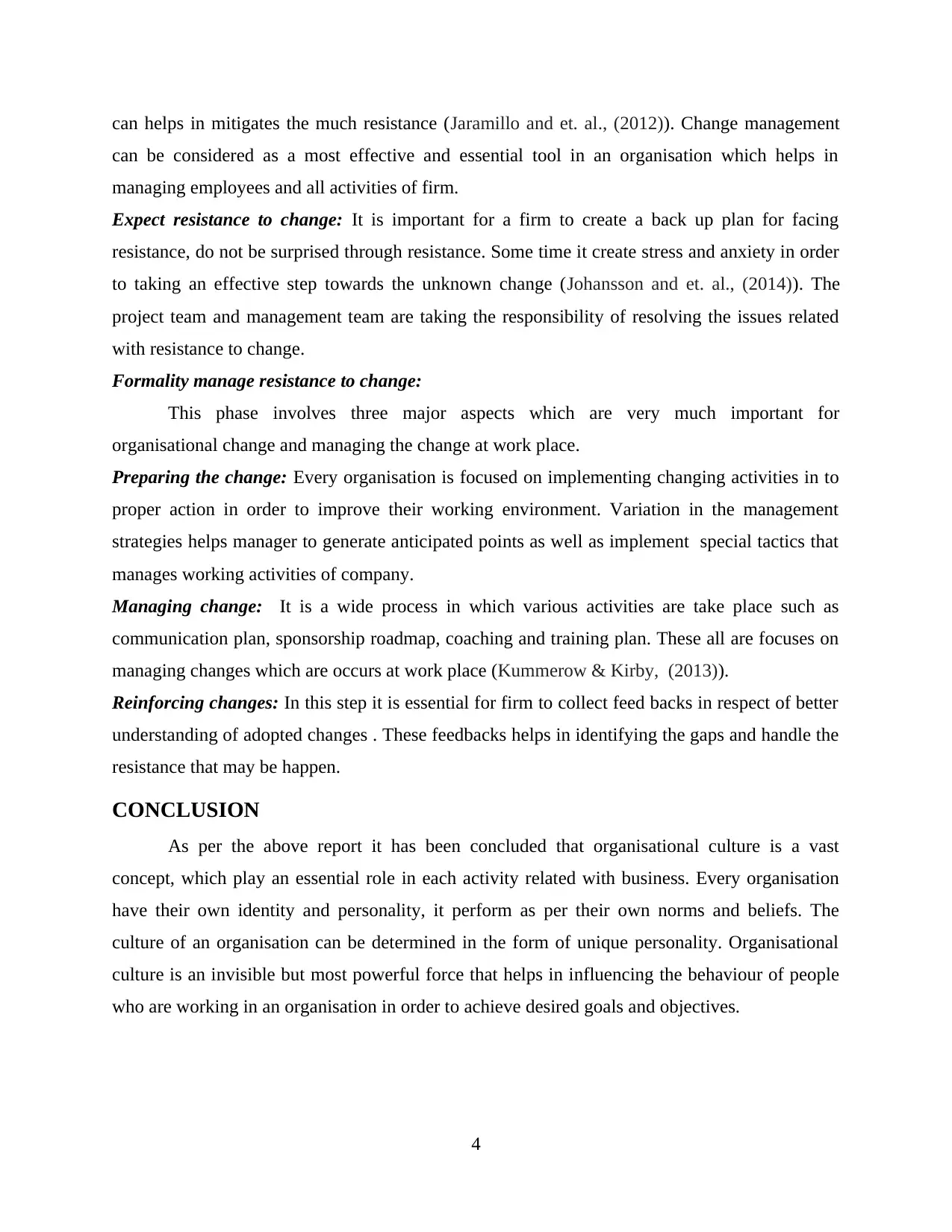
can helps in mitigates the much resistance (Jaramillo and et. al., (2012)). Change management
can be considered as a most effective and essential tool in an organisation which helps in
managing employees and all activities of firm.
Expect resistance to change: It is important for a firm to create a back up plan for facing
resistance, do not be surprised through resistance. Some time it create stress and anxiety in order
to taking an effective step towards the unknown change (Johansson and et. al., (2014)). The
project team and management team are taking the responsibility of resolving the issues related
with resistance to change.
Formality manage resistance to change:
This phase involves three major aspects which are very much important for
organisational change and managing the change at work place.
Preparing the change: Every organisation is focused on implementing changing activities in to
proper action in order to improve their working environment. Variation in the management
strategies helps manager to generate anticipated points as well as implement special tactics that
manages working activities of company.
Managing change: It is a wide process in which various activities are take place such as
communication plan, sponsorship roadmap, coaching and training plan. These all are focuses on
managing changes which are occurs at work place (Kummerow & Kirby, (2013)).
Reinforcing changes: In this step it is essential for firm to collect feed backs in respect of better
understanding of adopted changes . These feedbacks helps in identifying the gaps and handle the
resistance that may be happen.
CONCLUSION
As per the above report it has been concluded that organisational culture is a vast
concept, which play an essential role in each activity related with business. Every organisation
have their own identity and personality, it perform as per their own norms and beliefs. The
culture of an organisation can be determined in the form of unique personality. Organisational
culture is an invisible but most powerful force that helps in influencing the behaviour of people
who are working in an organisation in order to achieve desired goals and objectives.
4
can be considered as a most effective and essential tool in an organisation which helps in
managing employees and all activities of firm.
Expect resistance to change: It is important for a firm to create a back up plan for facing
resistance, do not be surprised through resistance. Some time it create stress and anxiety in order
to taking an effective step towards the unknown change (Johansson and et. al., (2014)). The
project team and management team are taking the responsibility of resolving the issues related
with resistance to change.
Formality manage resistance to change:
This phase involves three major aspects which are very much important for
organisational change and managing the change at work place.
Preparing the change: Every organisation is focused on implementing changing activities in to
proper action in order to improve their working environment. Variation in the management
strategies helps manager to generate anticipated points as well as implement special tactics that
manages working activities of company.
Managing change: It is a wide process in which various activities are take place such as
communication plan, sponsorship roadmap, coaching and training plan. These all are focuses on
managing changes which are occurs at work place (Kummerow & Kirby, (2013)).
Reinforcing changes: In this step it is essential for firm to collect feed backs in respect of better
understanding of adopted changes . These feedbacks helps in identifying the gaps and handle the
resistance that may be happen.
CONCLUSION
As per the above report it has been concluded that organisational culture is a vast
concept, which play an essential role in each activity related with business. Every organisation
have their own identity and personality, it perform as per their own norms and beliefs. The
culture of an organisation can be determined in the form of unique personality. Organisational
culture is an invisible but most powerful force that helps in influencing the behaviour of people
who are working in an organisation in order to achieve desired goals and objectives.
4
⊘ This is a preview!⊘
Do you want full access?
Subscribe today to unlock all pages.

Trusted by 1+ million students worldwide
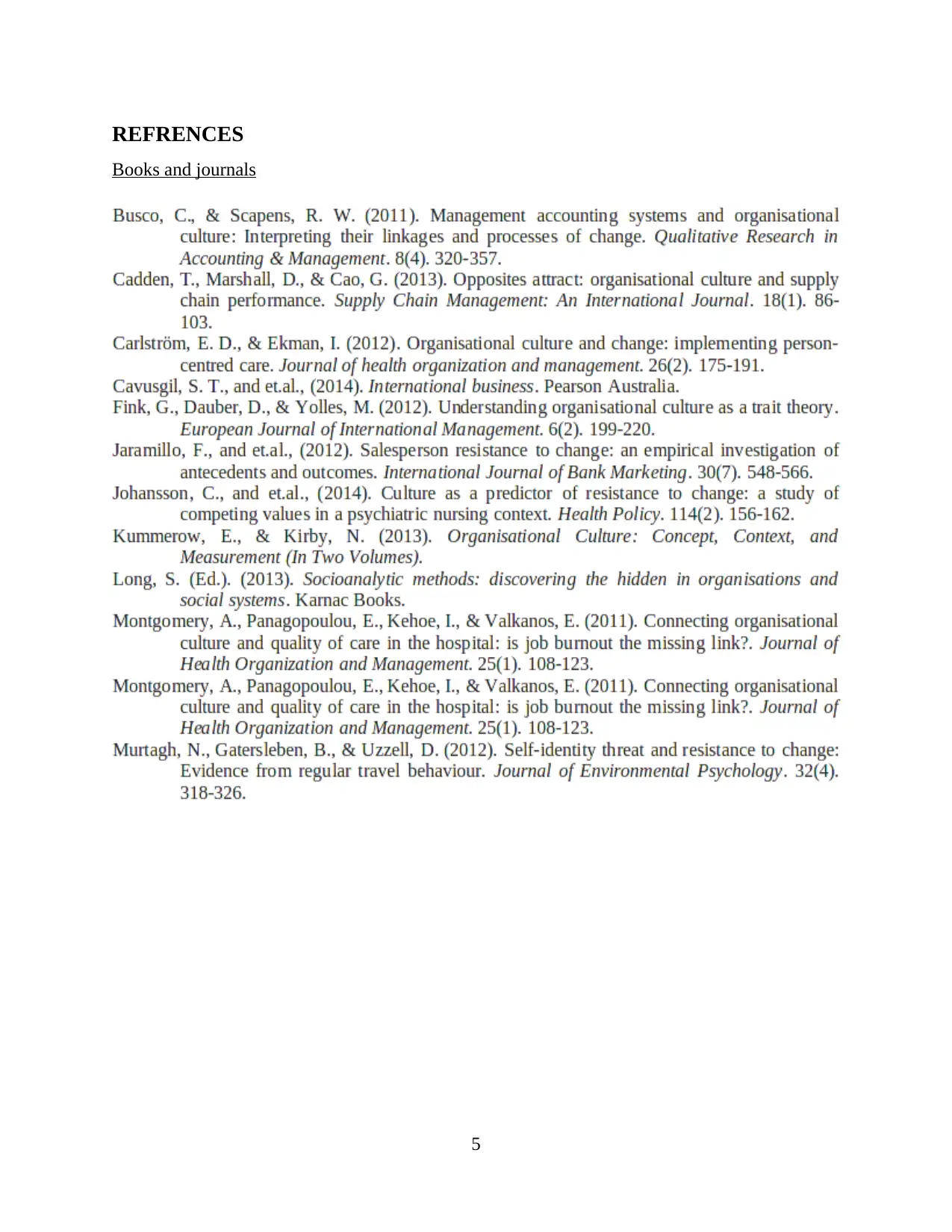
REFRENCES
Books and journals
5
Books and journals
5
Paraphrase This Document
Need a fresh take? Get an instant paraphrase of this document with our AI Paraphraser
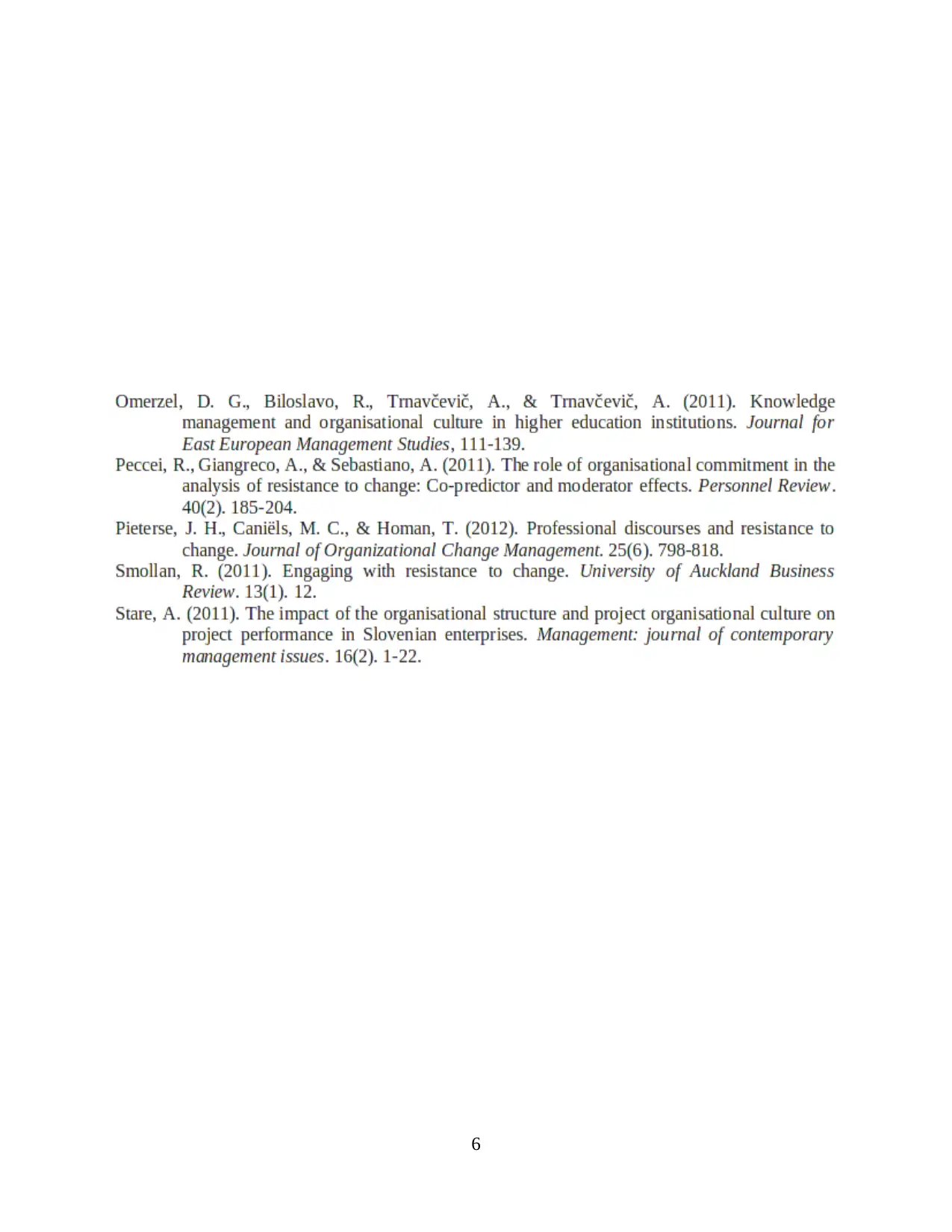
6
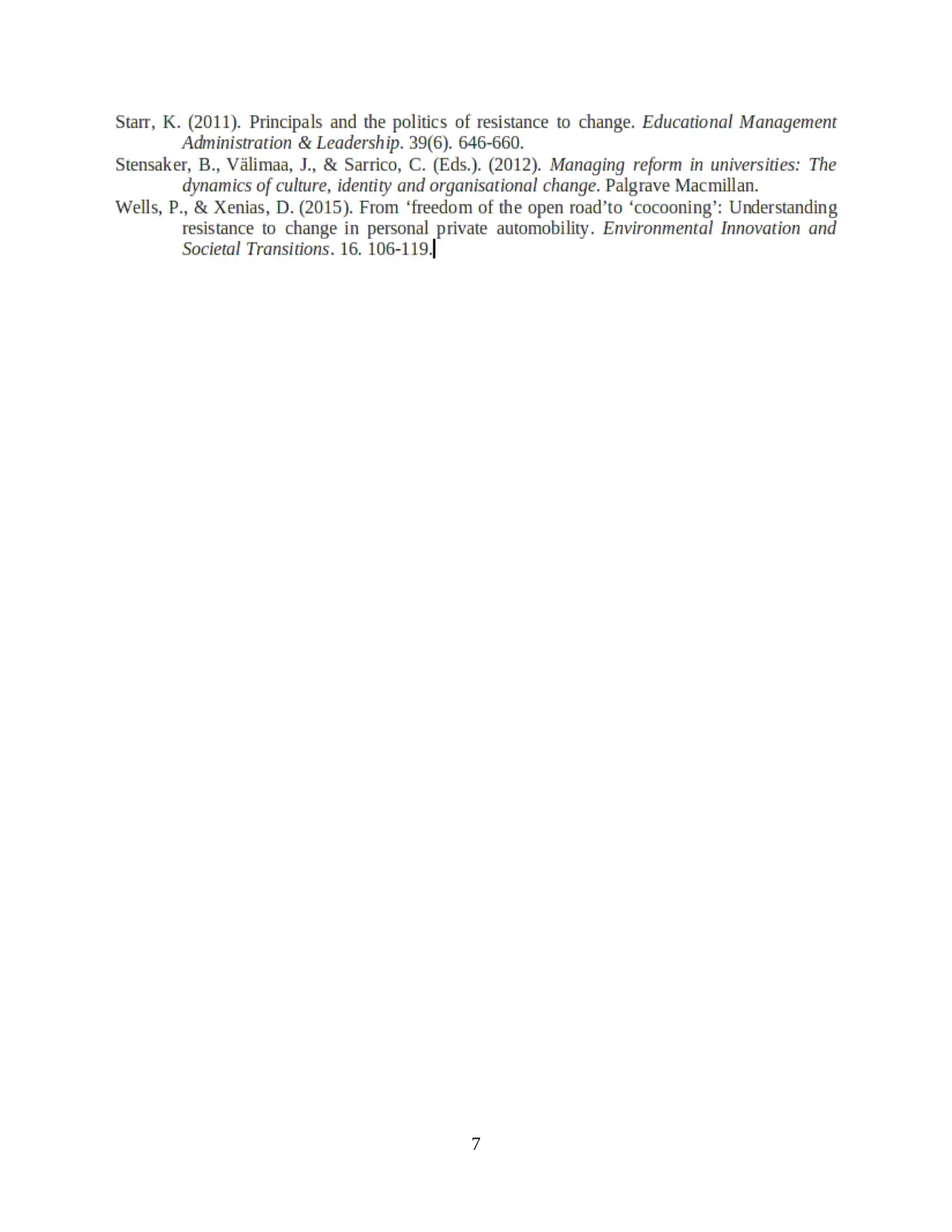
7
⊘ This is a preview!⊘
Do you want full access?
Subscribe today to unlock all pages.

Trusted by 1+ million students worldwide
1 out of 9
Related Documents
Your All-in-One AI-Powered Toolkit for Academic Success.
+13062052269
info@desklib.com
Available 24*7 on WhatsApp / Email
![[object Object]](/_next/static/media/star-bottom.7253800d.svg)
Unlock your academic potential
Copyright © 2020–2025 A2Z Services. All Rights Reserved. Developed and managed by ZUCOL.




